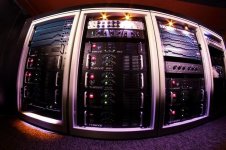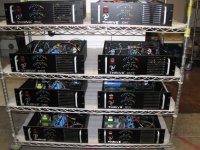While lateral MOSFETs make the best and simplest drivers for large amps, HEXFETS (now Vishay), are often favored for hobby use and smaller amps because of cost.
The issue with choosing HEXFETS is that the listed complementary devices are with regards to voltage and current ratings, and not for matching characteristics in linear use.
I was in charge of some R&D on this issue some time ago, at the time the results were proprietary. Surprising performance was obtained from common topologies by matching on resistance , gate capacitance, and transfer admittance as well as possible for a given minimum voltage and current requirement. Slew rate and distortion improved vastly over triple Darlington designs, especially when a dual differential front end was used. We used a bootstrapped "bias ladder" to obtain near rail-to-rail swing. Higher on resistance and lower transfer admittance tended to be the most linear. The important thing about MOSFETs is that as a voltage controlled device, it breaks the chain of current demand from propagating back to the VAS. That goes a long way towards negating distortion caused by general mismatch of base current draw by so called complementary output devices. That allows use of less open loop gain, and simpler front end design for a more open natural sound. Extensive MIT research in the 80s showed that the complex waveforms of music did not play well (pun) with long rates of loop closure associated with cascaded differentials and other complex methods used to bring down THD. These MOSFET pairs are all easily driven to high slew rates by any VAS with 10ma design current. If there is interest, I have more material on the HEXFET driver research.
Here are those pairs : 2A 2.5 OHM 1S class: IRF614 , IRF9610 , 4A 1 OHM 1S class: IRF624 , IRF9620 , 6A 1 OHM 3S class : IRF730 , IRF9630
The issue with choosing HEXFETS is that the listed complementary devices are with regards to voltage and current ratings, and not for matching characteristics in linear use.
I was in charge of some R&D on this issue some time ago, at the time the results were proprietary. Surprising performance was obtained from common topologies by matching on resistance , gate capacitance, and transfer admittance as well as possible for a given minimum voltage and current requirement. Slew rate and distortion improved vastly over triple Darlington designs, especially when a dual differential front end was used. We used a bootstrapped "bias ladder" to obtain near rail-to-rail swing. Higher on resistance and lower transfer admittance tended to be the most linear. The important thing about MOSFETs is that as a voltage controlled device, it breaks the chain of current demand from propagating back to the VAS. That goes a long way towards negating distortion caused by general mismatch of base current draw by so called complementary output devices. That allows use of less open loop gain, and simpler front end design for a more open natural sound. Extensive MIT research in the 80s showed that the complex waveforms of music did not play well (pun) with long rates of loop closure associated with cascaded differentials and other complex methods used to bring down THD. These MOSFET pairs are all easily driven to high slew rates by any VAS with 10ma design current. If there is interest, I have more material on the HEXFET driver research.
Here are those pairs : 2A 2.5 OHM 1S class: IRF614 , IRF9610 , 4A 1 OHM 1S class: IRF624 , IRF9620 , 6A 1 OHM 3S class : IRF730 , IRF9630
Attachments
How applicable were these tests to modern die shrinked parts, which seem to have all kinds of linear operation issisues compared with the original VFETS and early generation HEXFETS?
The parts listed here are still the legacy HEXFETS . Vishay took over some of the tooling of IR, and continued to make the same devices. If I remember correctly, IR retained their various trademarks , so "HEXFET" is not used by Vishay. Another good pair for really high power drivers, or even output stages is IRFP9240 / IRFP340 , these match quite well for audio. All of the Vishay parts listed here have been verified as valid replacement parts for old designs, they test the same as in 1998.How applicable were these tests to modern die shrinked parts, which seem to have all kinds of linear operation issisues compared with the original VFETS and early generation HEXFETS?
So, to answer the question, I am talking about older HEXFET types (minus the trademark) still made. Most of the newer parts have no real SOA for linear use, and no real linear region, they "snap" on soon as gate threshold is crossed. The VFETs which are advertised as designed for linear use have huge gate capacitances, and do not even approach having complementary pairs. That leaves only the older types made by Vishay , or lateral MOSFETs from Exicon.
SICFETs look promising, but only come as N channel for now, and quasi-comp MOSFET amps are not a good thing. Sure, some people have made them work, but it's sort of like climbing over the roof to get to the back door.
Interesting, I’ve used the IRF710 in combination with the 9610. But indeed, the 614 matches very good with the 9610 according datasheets. In my most recent amp, I’ve used the 2sk1530/2SJ201 to drive 7 pairs of Sanken BJT’s.
Attached is part of a schematic of an amp we designed in the 2000s. It shows the bias ladder used to obtain near rail to rail swing with HEXFET drivers. I deleted the complex output protection system. The bias ladder consists of 2 boot strapped current sources which can go beyond rails , zeners for the HEXFET gate threshold drop, and a VBE for output stage bias. The U3 bridge mounted on heat sink to sense temp. It doesn't need to be a bridge, but it was easier to mount to heat sink than round diodes. The "high drive" and "low drive" just went to the bases of 6 bipolar output pairs. Q7 , Q8 are the VAS. The VAS lifts this arrangement from the bottom, those diode connections are correct. We did try a version of this arrangement to direct drive 6 HEXFET pairs for output stage. The VAS for that test was Darlington for 100ma max current, and the current sources were set at 60 ma , that allowed over 60v/us slew rate. I thought the sonic signature was great, with exciting vocal and instrument presence , and tight bass that seemed to want to leap out of the speakers, But alas, the fact that the proprietary current protection circuits did not like HEXFET outputs, and the cost of hand matching HEXFETS led to just the drivers being HEXFETS. A lot of the HEXFET driver amps went into big clubs, mostly private labeled to the installers.
Attachments
The 2SK1530 / 2SJ201 were indeed a fantastic pair. We built amps with those as drivers, and some amplifiers using them as outputs up to the 2000s, great sound either way. Low gate threshold made for easy design.Interesting, I’ve used the IRF710 in combination with the 9610. But indeed, the 614 matches very good with the 9610 according datasheets. In my most recent amp, I’ve used the 2sk1530/2SJ201 to drive 7 pairs of Sanken BJT’s.
As I understand, HEXFET and TRENCH FET design is to optimize their Ron. Vanishing low. The idea if I remember is the reduction in hot-spot failures when you are turning them on very hard very fast. But that is not relevant at all for linear. What makes them suitable or not for linear use? I thought they were not very linear.
Many modern MOSFETs are optimized for RdsON and switching time - this results in a reduced SOA, similar to secondary breakdown in BJTs.
Last edited:
Low transconductance (gfs) HEXFETs maybe used in linear amplifiers, without much problem. Within each voltage range, International Rectifier / Vishay provides different optimisations say e.g. in the 100V series (IRF5x0/95x0), the lowest transconductance is seen in IRF510/9510, making it the most suitable choice from within the series.
Here's an an old application note on a HEXFET amplifier from the erstwhile International Rectifier company, which has not since been retained by Infineon, post acquisition. It seems IR openly promoted the idea of HEXFETs even in linear applications, in spite of their disadvantages. The pair used here is IRF530/9530.
Attachments
Yes, the older HEXFET types were indeed promoted for linear use, and they were fine. Later as SMPS applications led to optimizing MOSFETS for switching, manufacturers did not want want to be associated with linear applications, even for older types.Here's an an old application note on a HEXFET amplifier from the erstwhile International Rectifier company, which has not since been retained by Infineon, post acquisition. It seems IR openly promoted the idea of HEXFETs even in linear applications, in spite of their disadvantages. The pair used here is IRF530/9530.
- Home
- Design & Build
- Parts
- HEXFETS matching for drivers


